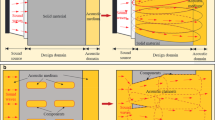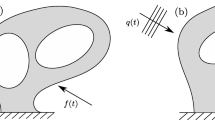Abstract
This research develops a new acoustic topology optimization scheme with a model order reduction called the Multifrequency Quasi Static Ritz Vector (MQSRV) method which effectively reduces the size of the system matrix for the calculating responses as well as sensitivity values in frequency domain. Computing the accurate acoustic responses and sensitivity values with the finite element (FE) method usually requires a significant amount of computational resources. For an efficient optimization, this research adopts recent developments in computational model order reduction approach having successfully exploited advanced mathematical development for calculating accurate solutions of partial differential equation. Among model order reduction schemes, the present study uses the MQSRV method which calculates the Ritz vector bases at multiple frequencies to minimize the amplitude of sound pressure in objective domain. Through several design examples, the efficiency and reliability of the MQSRV method for the acoustic topology optimization are verified.






















Similar content being viewed by others
References
Antoulas AC, Sorensen DC, Gugercin S (2000) A survey of model reduction methods for large-scale systems. Report
Choi Y, Oxberry G, White D et al (2019) Accelerating Topology Optimization Using Reduced Order Models. Report, Lawrence Livermore National Lab.(LLNL), Livermore, CA (United States)
Demo N, Ortali G, Gustin G et al (2021) An efficient computational framework for naval shape design and optimization problems by means of data-driven reduced order modeling techniques. Boll dell’Unione Mat Ital 14(1):211–230
Dühring MB, Jensen JS, Sigmund O (2008) Acoustic design by topology optimization. J Sound Vib 317(3–5):557–575
Gordon RW, Hollkamp JJ (2011) Reduced-order models for acoustic response prediction. Report, AIR FORCE RESEARCH LAB WRIGHT-PATTERSON AFB OH AIR VEHICLES DIRECTORATE
Gu J, Ma ZD, Hulbert GM (2000) A new load-dependent Ritz vector method for structural dynamics analyses: quasi-static Ritz vectors. Finite Elem Anal Des 36(3–4):261–278
Guyan RJ (1965) Reduction of stiffness and mass matrices. AIAA J 3(2):380
Han JS, Rudnyi EB, Korvink JG (2005) Efficient optimization of transient dynamic problems in MEMS devices using model order reduction. J Micromech Microeng 15(4):822
Heres PJ (2005) Robust and efficient Krylov subspace methods for model order reduction
Hu J, Yao S, Huang X (2020) Topology optimization of dynamic acoustic-mechanical structures using the ersatz material model. Comput Methods Appl Mech Eng 372(113):387
Kim KH, Yoon GH (2015) Optimal rigid and porous material distributions for noise barrier by acoustic topology optimization. J Sound Vib 339:123–142
Koh HS, Kim JH, Yoon GH (2020) Efficient topology optimization of multicomponent structure using substructuring-based model order reduction method. Comput Struct 228(106):146
Lee SH, Huang TY, Wu RB (2005) Fast waveguide eigenanalysis by wide-band finite-element model-order reduction. IEEE Trans Microw Theory Tech 53(8):2552–2558
Li Q, Sigmund O, Jensen JS et al (2021) Reduced-order methods for dynamic problems in topology optimization: A comparative study. Comput Methods Appl Mech Eng 387(114):149
Liu S, Li Q, Liu J et al (2018) A realization method for transforming a topology optimization design into additive manufacturing structures. Engineering 4(2):277–285
Ma ZD, Kikuchi N, Hagiwara I (1993) Structural topology and shape optimization for a frequency response problem. Comput Mech 13(3):157–174
Ma ZD, Kikuchi N, Cheng HC, et al (1995) Topological optimization technique for free vibration problems
Nguyen C, Zhuang X, Chamoin L et al (2020) Three-dimensional topology optimization of auxetic metamaterial using isogeometric analysis and model order reduction. Comput Methods Appl Mech Eng 371(113):306
Park GJ, Kang BS (2005) An overview of optimization of structures subjected to transient loads. Trans Korean Soc Mech Eng A 29(3):369–386
Pedersen NL (2000) Maximization of eigenvalues using topology optimization. Struct Multidiscip Optim 20(1):2–11
Remis RF (2010) An efficient model-order reduction approach to low-frequency transmission line modeling. Progress In Electromagnetics Research 101:139–155
Ricles J, Leger P (1993) Use of load-dependent vectors for dynamic analysis of large space structures. Commun Numer Methods Eng 9(11):897–908
Song Z, Su D, Duval F et al (2011) Model order reduction for PEEC modeling based on moment matching. Progress In Electromagnetics Research 114:285–299
Svanberg K (1987) The method of moving asymptotes-a new method for structural optimization. Int J Numer Meth Eng 24(2):359–373
Tango S, Azegami H (2022) Acceleration of shape optimization analysis using model order reduction by Karhunen-Loéve expansion. Jpn J Ind Appl Math 39(1):385–401
Tcherniak D (2002) Topology optimization of resonating structures using SIMP method. Int J Numer Meth Eng 54(11):1605–1622
Wilson EL (1985) A new method of dynamic analysis for linear and nonlinear systems. Finite Elem Anal Des 1(1):21–23
Wilson EL, Yuan M, Dickens JM (1982) Dynamic analysis by direct superposition of Ritz vectors. Earthq Eng Dyn, Struct 10(6):813–821
Wittig T, Schuhmann R, Weiland T (2006) Model order reduction for large systems in computational electromagnetics. Linear Algebra Appl 415(2–3):499–530
Xia L, Breitkopf P (2014) A reduced multiscale model for nonlinear structural topology optimization. Comput Methods Appl Mech Eng 280:117–134
Yao M (1996) Nonlinear structural dynamic finite element analysis using Ritz vector reduced basis method. Shock Vib 3(4):259–268
Yoon GH (2010) Structural topology optimization for frequency response problem using model reduction schemes. Comput Methods Appl Mech Eng 199(25–28):1744–1763
Yoon GH (2012) Toward a multifrequency quasi-static Ritz vector method for frequency-dependent acoustic system application. Int J Numer Meth Eng 89(11):1451–1470
Yoon GH, Jensen JS, Sigmund O (2007) Topology optimization of acoustic-structure interaction problems using a mixed finite element formulation. Int J Numer Meth Eng 70(9):1049–1075
Yoon Gil Ho, Kim Jun Hwan, Jung Kwang Ok, Jung Jae Won (2015) Transient quasi-static Ritz vector (TQSRV) method by Krylov subspaces and eigenvectors for efficient contact dynamic finite element simulation. Appl Math Model 39(9):2740–2762
Yue Y, Meerbergen K (2013) Accelerating optimization of parametric linear systems by model order reduction. SIAM J Optim 23(2):1344–1370
Zhao J, Wang C (2016) Dynamic response topology optimization in the time domain using model reduction method. Struct Multidiscip Optim 53(1):101–114
Acknowledgements
This work was supported by Korea Institute of Energy Technology Evaluation and Planning (KETEP) grant funded by the Korea government (MOTIE) (20202020800030, Development of Smart Hybrid Envelope Systems for Zero Energy Buildings through Holistic Performance Test and Evaluation Methods and Fields Verifications) and by the National Research Foundation of Korea (NRF) grant funded by the Korea government (MSIT) (No. 2018R1A5A7025522).
Author information
Authors and Affiliations
Contributions
These authors contributed equally to this study. Conceptualization: [Gil Ho Yoon], Methodology: [Gil Ho Yoon], Validation, Resources: [Gil Ho Yoon], Writing - Review & Editing: [Gil Ho Yoon], Supervision: [Gil Ho Yoon], Project administration: [Gil Ho Yoon], Formal analysis: [Myung Shin], Investigation: [Myung Shin], Writing - Original draft: [Myung Shin], Visualization: [Myung Shin].
Corresponding author
Ethics declarations
Conflict of interest
The authors declare that they have no known competing financial interests or personal relationships that could have appeared to influence the work reported in this paper. The authors declare the following financial interests/personal relationships which may be considered as potential competing interests.
Additional information
Publisher's Note
Springer Nature remains neutral with regard to jurisdictional claims in published maps and institutional affiliations.
Rights and permissions
About this article
Cite this article
Shin, M., Yoon, G.H. Efficient acoustic topology optimization with the Multifrequency Quasi-Static Ritz vector (MQSRV) method. Comput Mech 70, 993–1011 (2022). https://doi.org/10.1007/s00466-022-02196-5
Received:
Accepted:
Published:
Issue Date:
DOI: https://doi.org/10.1007/s00466-022-02196-5




